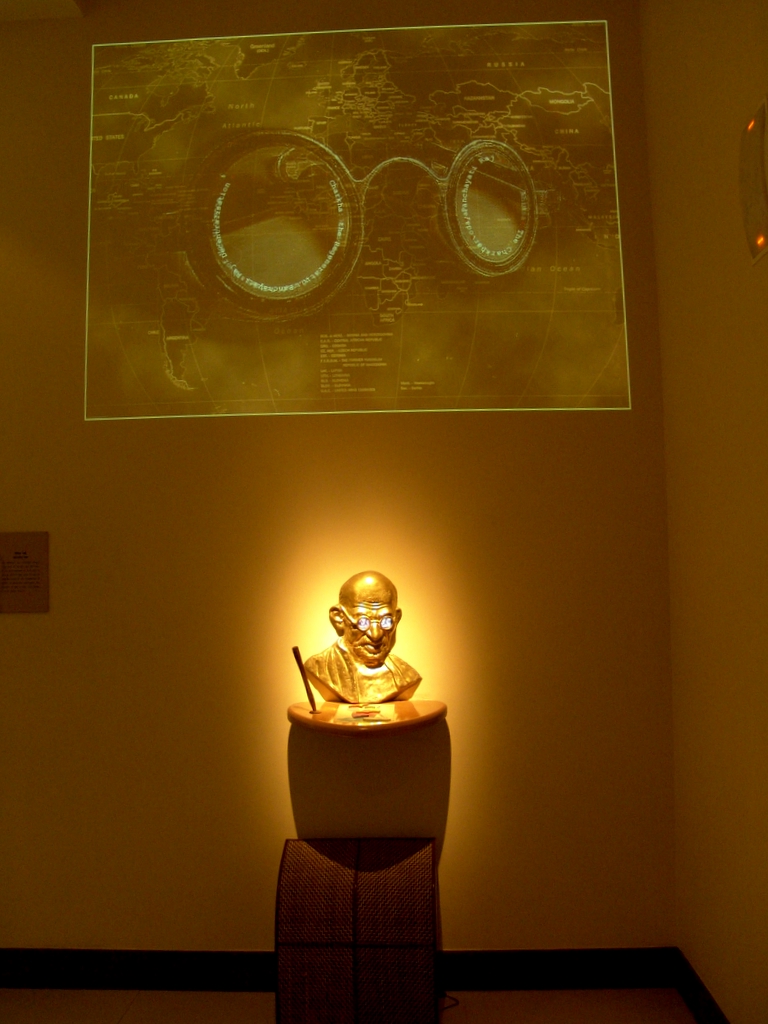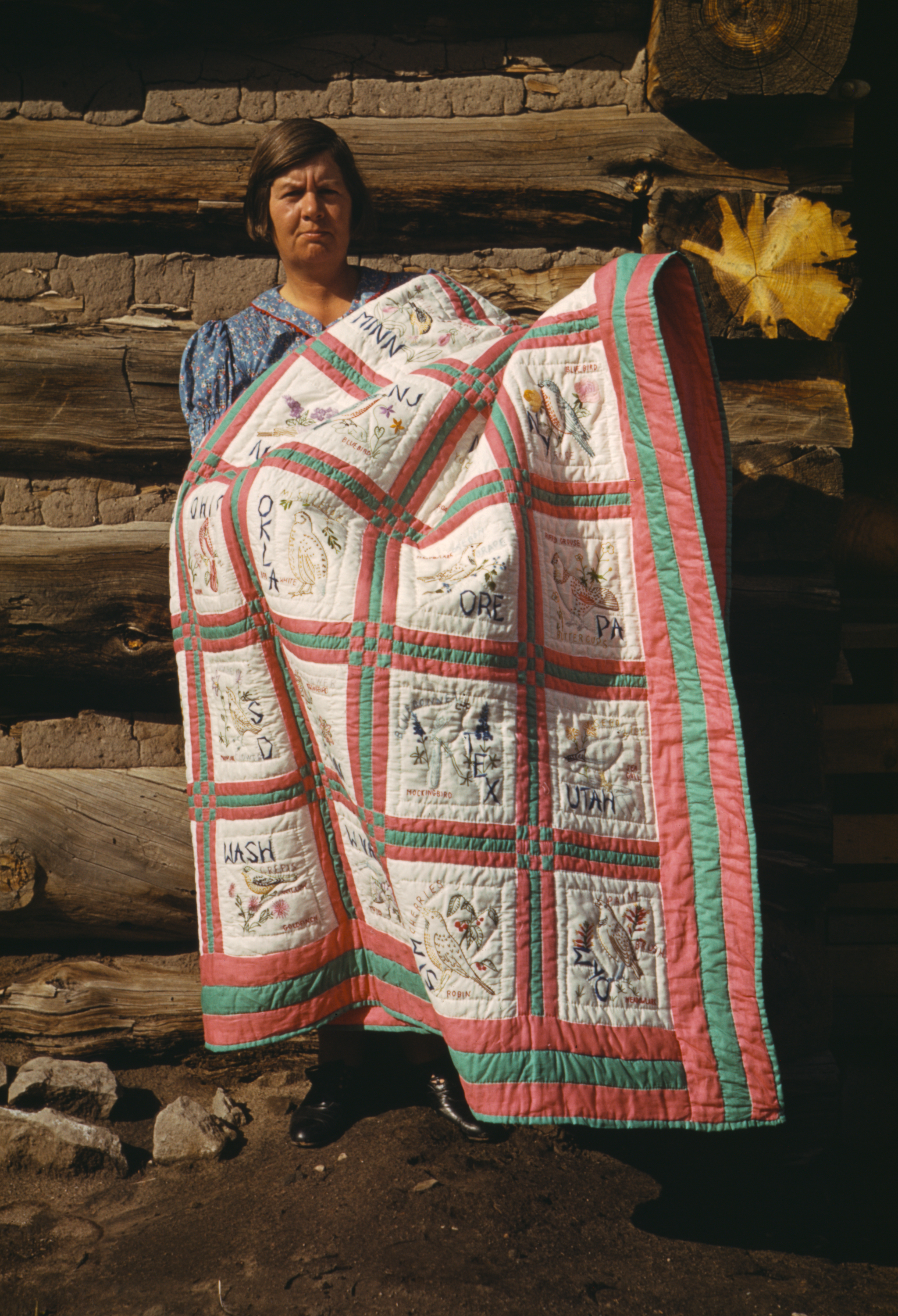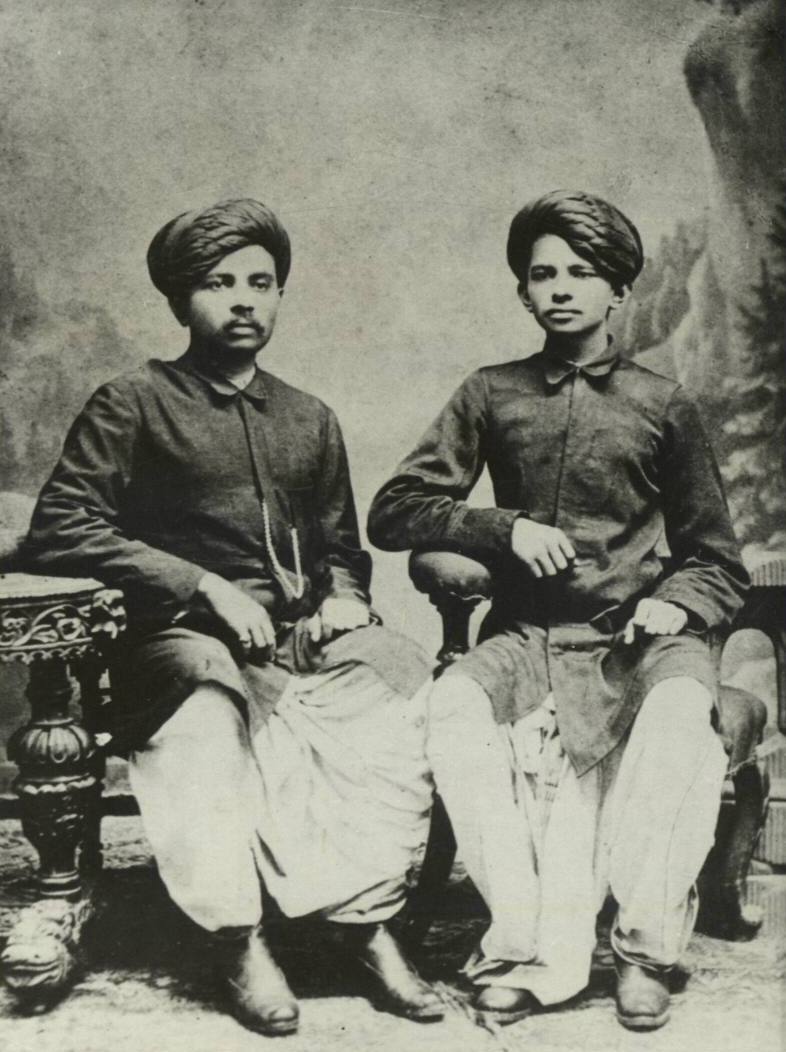|
Eternal Gandhi Multimedia Museum
__NOTOC__ The Eternal Gandhi Multimedia Museum is a digital multimedia museum established in 2005. It is located at Gandhi Smriti, formerly Birla House, the site where Mohandas Karamchand Gandhi was assassinated. The museum presents historical records of Gandhi's life, and aims to revive and redefine the values by which India obtained freedom. History The project is an initiative of the Aditya Birla Group and Gandhi Smriti Darshan Samiti. It is supported by Grasim and Hindalco, and developed by the Sacred World Research Laboratory. The museum was inaugurated on 14 April 2005 by Indian Prime Minister Manmohan Singh. The exhibition includes displays derived from classical Indian symbols such as the spinning wheel, turning prayer wheels, touching symbolic pillars, the act of hands touching sacred objects, and collaboratively constructed quilts. It embellishes the life of Gandhi in rhythmic with photographs, paintings, film footage, and video clips. A collection of over 40 exhibits ... [...More Info...] [...Related Items...] OR: [Wikipedia] [Google] [Baidu] |
Quilt
A quilt is a multi-layered textile, traditionally composed of two or more layers of fabric or fiber. Commonly three layers are used with a filler material. These layers traditionally include a woven cloth top, a layer of batting or wadding, and a woven back combined using the techniques of quilting. This is the process of sewing on the face of the fabric, and not just the edges, to combine the three layers together to reinforce the material. Stitching patterns can be a decorative element. A single piece of fabric can be used for the top of a quilt (a "whole-cloth quilt"), but in many cases the top is created from smaller fabric pieces joined, or patchwork. The pattern and color of these pieces creates the design. Quilts may contain valuable historical information about their creators, "visualizing particular segments of history in tangible, textured ways." In the twenty-first century, quilts are frequently displayed as non-utilitarian works of art but historically quilts ... [...More Info...] [...Related Items...] OR: [Wikipedia] [Google] [Baidu] |
Gandhi Museums
Mohandas Karamchand Gandhi (; ; 2 October 1869 – 30 January 1948), popularly known as Mahatma Gandhi, was an Indian lawyer, anti-colonial nationalist Quote: "... marks Gandhi as a hybrid cosmopolitan figure who transformed ... anti-colonial nationalist politics in the twentieth-century in ways that neither indigenous nor westernized Indian nationalists could." and political ethicist Quote: "Gandhi staked his reputation as an original political thinker on this specific issue. Hitherto, violence had been used in the name of political rights, such as in street riots, regicide, or armed revolutions. Gandhi believes there is a better way of securing political rights, that of nonviolence, and that this new way marks an advance in political ethics." who employed nonviolent resistance to lead the successful campaign for India's independence from British rule, and to later inspire movements for civil rights and freedom across the world. The honorific ''Mahātmā'' (Sanskrit ... [...More Info...] [...Related Items...] OR: [Wikipedia] [Google] [Baidu] |
Museums In Delhi
A museum ( ; plural museums or, rarely, musea) is a building or institution that cares for and displays a collection of artifacts and other objects of artistic, cultural, historical, or scientific importance. Many public museums make these items available for public viewing through exhibits that may be permanent or temporary. The largest museums are located in major cities throughout the world, while thousands of local museums exist in smaller cities, towns, and rural areas. Museums have varying aims, ranging from the conservation and documentation of their collection, serving researchers and specialists, to catering to the general public. The goal of serving researchers is not only scientific, but intended to serve the general public. There are many types of museums, including art museums, natural history museums, science museums, war museums, and children's museums. According to the International Council of Museums (ICOM), there are more than 55,000 museums in 202 countrie ... [...More Info...] [...Related Items...] OR: [Wikipedia] [Google] [Baidu] |
The Washington Post
''The Washington Post'' (also known as the ''Post'' and, informally, ''WaPo'') is an American daily newspaper published in Washington, D.C. It is the most widely circulated newspaper within the Washington metropolitan area and has a large national audience. Daily broadsheet editions are printed for D.C., Maryland, and Virginia. The ''Post'' was founded in 1877. In its early years, it went through several owners and struggled both financially and editorially. Financier Eugene Meyer purchased it out of bankruptcy in 1933 and revived its health and reputation, work continued by his successors Katharine and Phil Graham (Meyer's daughter and son-in-law), who bought out several rival publications. The ''Post'' 1971 printing of the Pentagon Papers helped spur opposition to the Vietnam War. Subsequently, in the best-known episode in the newspaper's history, reporters Bob Woodward and Carl Bernstein led the American press's investigation into what became known as the Waterga ... [...More Info...] [...Related Items...] OR: [Wikipedia] [Google] [Baidu] |
Aditya Birla
Aditya Vikram Birla (14 November 1943 – 1 October 1995) was an Indian industrialist. Born into one of the largest business families of India, he oversaw the diversification of his group into textiles, petrochemicals and telecommunications. He was one of the first Indian industrialists to expand abroad, setting up plants in Southeast Asia, the Philippines and Egypt. His net worth was estimated at £250 million by 1995. His death at the age of 51 left his young son Kumar Mangalam Birla in charge of his group of companies. Early life and education Birla was born on 14 November 1943 in Calcutta to industrialist Basant Kumar and Sarala Birla. His grandfather Ghanshyam Das Birla was an associate of Mahatma Gandhi and had built his fortune on aluminium prospecting and as the manufacturer of the Ambassador car. After attending St. Xavier's College, Calcutta, he earned a degree in chemical engineering at the Massachusetts Institute of Technology. He was married to Rajashri and ... [...More Info...] [...Related Items...] OR: [Wikipedia] [Google] [Baidu] |
Sabarmati Ashram
Sabarmati Ashram (also known as Gandhi Ashram) is located in the Sabarmati suburb of Ahmedabad, Gujarat, adjoining the Ashram Road, on the banks of the River Sabarmati, from the town hall. This was one of the many residences of Mahatma Gandhi who lived at Sabarmati (Gujarat) and Sevagram ( Wardha, Maharashtra) when he was not travelling across India or in prison. He lived in Sabarmati or Wardha for a total of twelve years with his wife Kasturba Gandhi and followers, including Vinoba Bhave. The Bhagavad Gita was recited here daily as part of the Ashram schedule. It was from here that Gandhi led the Dandi march also known as the Salt Satyagraha on 12 March 1930. In recognition of the significant influence that this march had on the Indian independence movement, the Indian government has established the ashram as a national monument. History Gandhiji's India ashram was originally established at the Kocharab Bungalow of Jivanlal Desai, a barrister and friend of Gandhi, ... [...More Info...] [...Related Items...] OR: [Wikipedia] [Google] [Baidu] |
Gandhi Memorial Museum, Madurai
Gandhi Memorial Museum, established in 1959, is a memorial museum for Mahatma Gandhi located in the city of Madurai in Tamil Nadu, India. Known as Gandhi Museum, it is now one of the five Gandhi Sanghralayas (Gandhi Museums) in the country. It includes a part of the blood-stained garment worn by Gandhi when he was assassinated by Nathuram Godse. History Years after the assassination of Mahatma Gandhi, in 1948 an appeal was made to the citizens of India nationwide to build memorials for him. With the help of contributions from poor and rich citizens of India, a trust was established for this cause, the Mahatma Gandhi National Memorial Trust. This museum was inaugurated by the former Prime Minister Jawaharlal Nehru on 15 April 1959. Gandhi Memorial Museum in Madurai comes under the Peace Museums Worldwide selected by the United Nations Organisation (UNO). The palace of Rani Mangammal was renovated and converted into the museum. It is near the Madurai Collector Office. Collections ... [...More Info...] [...Related Items...] OR: [Wikipedia] [Google] [Baidu] |
National Gandhi Museum
The National Gandhi Museum or Gandhi Memorial Museum is a museum located in New Delhi, India showcasing the life and principles of Mahatma Gandhi. The museum first opened in Mumbai, shortly after Gandhi was assassinated in 1948. The museum relocated several times before moving to Raj Ghat, New Delhi in 1961. History Mahatma Gandhi was assassinated on 30 January 1948. Shortly after his death, collectors began searching India for anything of importance about Gandhi. Originally the personal items, newspapers, and books related to Gandhi were taken to Mumbai. In 1951, the items were moved to buildings near the Kota House in New Delhi. The museum moved again in 1957 to a mansion. In 1959, The Gandhi Museum moved for a final time to Rajghat, New Delhi next to the Samadhi of Mahatma Gandhi. The museum officially opened in 1961, on the 13th anniversary of Mahatma Gandhi's assassination, when Dr. Rajendra Prasad, then President of India, formally opened the new location. Library Thi ... [...More Info...] [...Related Items...] OR: [Wikipedia] [Google] [Baidu] |
Ranjit Makkuni
Ranjit Makkuni is an international multimedia artist and designer, the honorary director of the design think tank, the ''Sacred World Research Laboratory,'' as well as a musician, sitar player, and songwriter. His multimedia museum works are intersections between traditional and modern art, design and technology, such that the results help both traditional and modern cultures. They are intended to show that the wisdom of traditional communities can positively negate the homogenizing influences of modern technology; and that the intelligence, creativity and sense of freedom afforded by modern design and technology can reciprocally help traditional artists. His major works are several museum projects: ''Eternal Gandhi Multimedia Museum, ''Planet Health Museum'', ''The Goddess and Temples of Music'', and ''The Crossing: Living, Dying and Transformation in Banaras''. Education and research Makkuni obtained a B.Arch. from IIT Kharagpur, and a Masters in Design Theory and Methods from ... [...More Info...] [...Related Items...] OR: [Wikipedia] [Google] [Baidu] |
Green Art
Green is the color between cyan and yellow on the visible spectrum. It is evoked by light which has a dominant wavelength of roughly 495570 nm. In subtractive color systems, used in painting and color printing, it is created by a combination of yellow and cyan; in the RGB color model, used on television and computer screens, it is one of the additive primary colors, along with red and blue, which are mixed in different combinations to create all other colors. By far the largest contributor to green in nature is chlorophyll, the chemical by which plants photosynthesize and convert sunlight into chemical energy. Many creatures have adapted to their green environments by taking on a green hue themselves as camouflage. Several minerals have a green color, including the emerald, which is colored green by its chromium content. During post-classical and early modern Europe, green was the color commonly associated with wealth, merchants, bankers, and the gentry, while red was ... [...More Info...] [...Related Items...] OR: [Wikipedia] [Google] [Baidu] |
Tactile Computing
Tactile may refer to: * Tactile, related to the sense of touch * Haptics (other) * Tactile (device), a text-to-braille translation device See also * Tangibility, in law * Somatosensory system In physiology, the somatosensory system is the network of neural structures in the brain and body that produce the perception of touch ( haptic perception), as well as temperature ( thermoception), body position ( proprioception), and pain. I ..., where sensations are processed * CD96, for the T-cell receptor * {{disambiguation ... [...More Info...] [...Related Items...] OR: [Wikipedia] [Google] [Baidu] |







